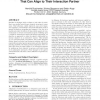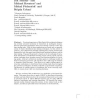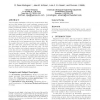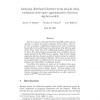148 search results - page 28 / 30 » Multi Agent Based Simulation: Beyond Social Simulation |
ATAL
2010
Springer
13 years 8 months ago
2010
Springer
Speakers in dialogue tend to adapt to each other by starting to use similar lexical items, syntactic structures, or gestures. This behaviour, called alignment, may serve important...
IJIIDS
2008
13 years 7 months ago
2008
: Growing importance of distributed data mining techniques has recently attracted attention of researchers in multiagent domain. Several agent-based application have been already c...
KDD
2009
ACM
14 years 8 months ago
2009
ACM
The increasing availability of electronic communication data, such as that arising from e-mail exchange, presents social and information scientists with new possibilities for char...
MLMTA
2003
13 years 8 months ago
2003
Abstract— The prediction of the future states in MultiAgent Systems has been a challenging problem since the begining of MAS. Robotic soccer is a MAS environment in which the pre...
JCSS
2008
13 years 7 months ago
2008
Internet worms are classically described using SIR models and simulations, to capture the massive dynamics of the system. Here we are able to generate a differential equation-base...




